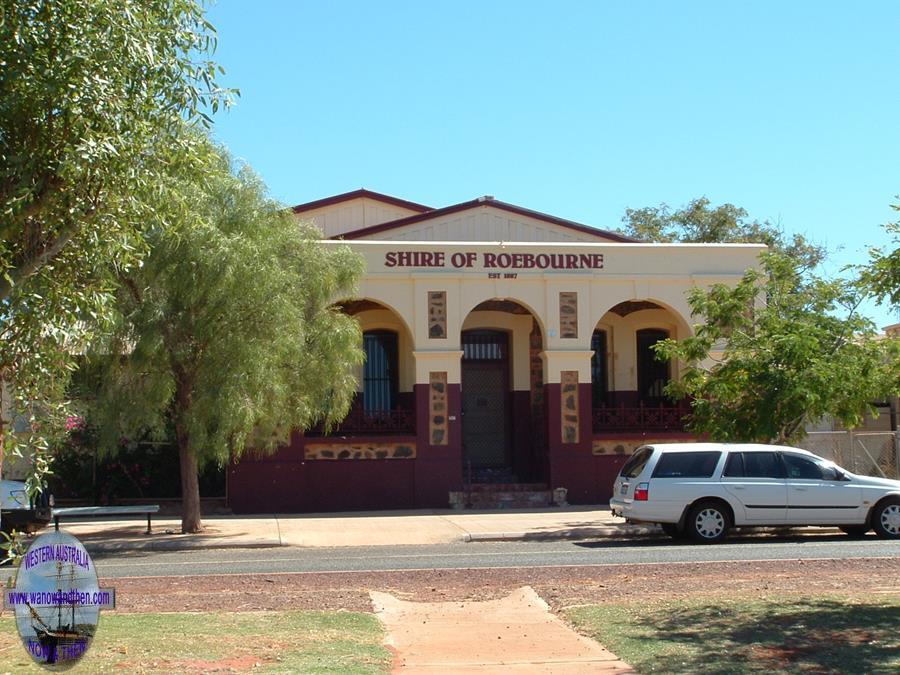|
|
|||
|
|
|
|
|
|
|
|||
|
|
ROEBOURNE
GPS 20 46 18 S 117 08 42 E
|
|||||||||
| ||||||||||
|
|
||||||||||
|
WE NEED YOUR SUPPORT. |
||||||||||
|
|
|
|
|
STATISTICS
SERVICES
CARAVAN PARKS
HOTEL / MOTEL / B AND B
|
DESCRIPTION
Roebourne for a long time had a dirty run-down feel to it but the mining boom in the area has led to the smaller towns in the area, like Roeboure, receiving a lot more attention and development. By 2015 the town had been greatly improved and many new buildings erected.
The area was known for many years as the Shire of Roebourne but with the greater emphacis on Karratha and the 'Cities of the North' program starting to take shape, the municipality became the 'City of Karrahta' on 1 July 2014.
Twenty seven kilometres south of Roebourne is the Harding Dam. There is a pleasant recreation area at the foot of the dam wall but care should be taken if visiting the dam due to the presence of mosquitoes and the associated diseases that they carry.
If you turn off Highway One towards the coast at Roebourne you will find Cossack, Wickham and Point Samson only a few kilometres away.
HISTORY
Phillip Parker King explored the coast in 1818 and named Nichol Bay. Later in 1861 Francis Gregory arrived on the ship Dolphin.
Walter Padbury and John Wellard landed on the coast in 1863 with stock and supplies and were followed in 1864 by John and Emma Withnell (aboard the Sea Ripple) who founded Mount Welcome Station after finding fresh water upstream from Cossack.
While Padbury and Wellard had been the first to arrive but they had both departed within five years and it was to be John and Emma Withnell and their relations who would stay to open up the area.
The Withnells had an uncomfortable and potentially deadly introduction to the north west when, on their near arrival at DeGrey, a violent storm drove their ship ashore on a high tide and it was damaged by rocks. Stock was unloaded and in the time it took to get the ship re-floated, many sheep had wandered off or had died from drinking salt water. When the ship was patched and re-floated it sailed back to Tien Tsin Harbour which was to become their home by accident. The Withnells lost around 150 sheep which was a huge blow.
William Shakespere Hall was near the landing when the Withnells arrived and wrote the following about their arrival:
'Withnell poor fellow, was all done in and the women and children were landed in the boiling heat without breakfast or a drop of water, the poor little children were crying for some.'
Emma Withnell (nee Hancock) was a cousin of F.T. Gregory who had explored the area and later recommended it to Emma as a good place to settle and raise livestock. One can only wonder what she thought on her arrival.
The town was named after John Septimus Roe (surveyor general.) The Aboriginal name for the area was Yeeramukadoo meaning place of figs - wild bush figs were plentiful along sections of the Harding River.
It is the oldest town on the north west coast. The townsite was declared in 1866 and gazetted in 1871.
In 1887 the Nickol (Nichol appears to be the correct spelling as the district of Nichol Bay was gazetted on January 25th 1871) Bay District was abolished and the town of Cossack, Municipality of Roebourne and Roebourne Road Board District were gazetted. In 1910 the town of Cossack and the Municipality of Roebourne were dissolved and amalgamated with the Roebourne Road Board. In 1914 Wards were gazetted, West Ward, East Ward and Central Ward. The number of members for these Wards were allocated in 1916, West Ward 2, East Ward 2 and Central Ward 3.
Due to the high cost of transporting livestock by sea (fees as high as 13/- a head for sheep were charged) there was a great need to open up an inland stock route to the south.
The first person to attempt this was Timothy Hooley who left Newcastle (Toodyay) on November 8th 1865 looking for a way to reach the north west. His first attempt failed but on his second expedition he found a way through and this was to become an important stock route for moving stock to and from the north west coast.
Over a period of time the area was reduced to form the various other Road Districts, including Ashburton, Port Hedland, Tableland etc. Until in 1971 the area of Council was reduced to 5900 square miles. The area included the towns of Roebourne, Cossack, Point Samson, Whim Creek, Dampier, Karratha, Wickham and Stations; Mardie, Karratha, Mt Welcome, Woodbrook, Warambie, Pyramid, Sherlock, Mallina and Cooya Pooya. The Boards operations continued on a small scale of maintaining roads and services. The Board changed names to the Shire of Roebourne in 1961. It was not until the iron ore activities commenced that the Shire began to grow.
Archaeological dating of the area, indicates that Aborigines have inhabited the Region for at least 20,000 years. Roebourne was developed on land which falls within the boundaries of the Ngaluma tribal country. The Ngaluma inhabited the "flood country" from the Maitland River in the West, to the Peewah River in the East, an area of approximately 6,400 square kilometres.
To the early Europeans, the Pilbara seemed harsh and inhospitable. The traditional Natives thrived on the natural resources, which they found in abundance. Kangaroos, emu and goanna were hunted, fish were speared by men and shellfish collected by women and children. A variety of native plants constituted a significant part of the Aboriginal diet. The wood from the river gum was used for making clubs and amongst its roots could be found edible grubs.
The first settlers in the area employed the Ngaluma people as shepherds and labourers in exchange for tobacco, flour and goods. A shortage of supplies and a severe drought from 1864 - 1866 caused the settlers to rely heavily on fish and game supplied to them by the Aboriginals. With the rapid development of the pastoral and pearling industries in the 1800s, coastal tribes of the Pilbara suffered dramatic interference with their traditional cultural life. The alienation from their land, fouling of water holes by stock and desecration of sacred sights eventually led to violent clashes with settlers.
The Aboriginal people fared worse in these clashes, and at least three large scale massacres are said to have taken place. One such clash became known as the Flying Foam Massacre. Reports exist of the killing of between 40 and 60 Aboriginals by colonists in retaliation for the spearing to death of a Police Constable (W. Griffiths), his Aboriginal Assistant (Peter) and two pearlers (another source says one pearler - called Jermyn was missing presumed killed). Accounts we have found show that these figures are hugely exaggerated and in fact only 3 Aborigines were shot and killed near the mouth of the Maitland River and 4 arrested with two of those being imprisoned for the murders.
Soon after the sheep arrived the colonists found pearl shell, and the rush that followed saw the Dampier Archipelago and Cossack became one of the largest pearling centres in the world. Because the Colonial Government would not allow convicts to be shipped up North, the Aboriginals were pressed as shell gatherers in the shallow waters along the coast. With the depletion of the easily accessible stock the Aboriginal men, women and children were used as forced labour to dive for shells from the pearling boats. Aboriginals from neighbouring tribes were also recruited for the pearling industry. Local tribal members were taken out of the area to other pearling grounds. By 1869 labour for the pearling boats was scarce, pearlers and "entrepreneurs" sailed along the coast as far South as the Ashburton River and North to the DeGrey River recruiting Aborigines to work as divers. In many cases if inducement failed, the Aboriginals were kidnapped, chained and marched to the coast. Once aboard the pearling boats, they may have been transported to pearling grounds hundreds of kilometres away and abandoned there at the end of the pearling season.
Introduced European diseases such as Measles and Small Pox claimed the lives of many Natives. The remaining survivors were forced to work on Pastoral leases in exchange for food and clothing. This gave the Aboriginals an opportunity to remain in touch with their traditional land and to protect their sacred places.
In the 1930s, Aboriginals from neighbouring tribes were moved into a Reserve in Roebourne. Injibandi, Banjima, Gurrama and Marduthunia were all mixed together. This, together with other tribal people who moved to the coastal European settlements from inland regions weakened the Ngaluma social structure even further.
The dominant Aboriginal language group living in Roebourne today are the Injibandi, while there are many Ngaluma, Banjima and Gurrama speakers, it is Injibandi language and cultural influence that prevail. There are no surviving members of the Jaburara tribe alive today, their engravings and sites are the only remaining evidence of their existence.
Despite their tragic history, the indigenous people of the area are now achieving the re-establishment of their cultural and traditional links with the land, the Elders efforts of re-connecting their grandchildren to their roots through cultural revival is giving the community a vision of a positive future for their people.
The old Roebourne gaol was constructed in 1896 and was used mainly to 'control' the local native population. The Master and Servant Act was used to punish Aborigines by imprisoning those who absconded from work. In many cases the Aboriginal people were tricked into signing contracts which then could be used to enforce a system of slave labour.
It was the appalling treatment of the Aborigines in the north west (mostly by pearling lugger Masters) and the abduction and rape of Aboriginal girls and women by both settlers and pearling crews that was to lead to the high number of Europeans attacked and killed by Aboriginal tribes in the area.
Europeans could beat Aborigines, burn them, whip them and even on occasions kill them and only the most minimal punishments (if any at all) were handed out.
When he was appointed Resident Magistrate in Roebourne, Edward Angelo tied to stop the abuse but was met by a wall of indifference and resistance both from local settlers and by the Governor in Perth.
In frustration he went over the Governor's head, directly to the Secretary of State for the Colonies in London. This breach of etiquette led to Angelo being transferred to Bunbury and then almost immediately moved on to the Aboriginal prison at Rottnest.
While this was a set back for Angelo, it was a boon to the Aboriginal prisoners who Angelo treated with respect. He made sure they were fed properly and even campaigned for reductions in their sentences.
Angelo always believed that it was unjust for Aborigines to be judged by a system they could not understand. He retired to Fremantle and died in 1902.
On May 1st 1946 there was a co-ordinated strike by Aborigines working on stations through out the Pilbara. European stockmen were earning $3-$5 a week while Aborigines were receiving 60c - $1.50 and the Aboriginal workers were now asking for a minimum of $3 a week. Station owners objected that Aboriginal workers did not work 8 hours days unless it was shearing time and that the stations also paid for food and clothing for the workers families that lived on the station. Some stations were already paying higher wages and these were exempt from the strike. Many Aborigines simply walked off the stations never to return. The dispute dragged on in places until 1949 by which time most stations were paying the $3 a week rate but the strike left much bad feeling in the region for many years afterward.
The old Roebourne gaol closed in 1924 but due to increasing population it was re-opened in 1973 and remained in use until 1984. The new gaol (located just a few kilometres from the original) is ultra-modern and its inmates are still mostly Aboriginal which shows that even in the 21st Century we haven't come very far from the 'bad old days'.
TALL TALES AND TRUE
Mother of the North
Early life in the north west was very tough and women often had to run the homestead on their own when the men were away tending to stock. Emma Withnell told the following story in her diary:
'After I had put my dear little ones to bed, I tried to read, but I could not settle down to my book. The dogs kept up a continual barking, and I thought that wild bush natives were camped nearby. Perhaps, I thought, they had seen my husband riding away that morning, and were planning to attack the homestead. Pulling aside the curtains to the kitchen window, I peered out. To my horror there was a black figure about a chain away from the house. I kept a rifle in the corner of the room, and I rushed over, seized and loaded it. Returning I opened the window, slipped the barrel of the rifle through and called out: "Go away or I'll fire". In the dim light the figure took on a menacing attitude, and appeared to move its head in a sinister way. "Go away, go away!" I screamed again. Then I pressed the trigger. I knew I had hit the object, but it still remained upright. Seizing a hurricane lantern, I ran out to investigate. To my relief the "wild bush native" about to attack us was a dress and hat I had hung to dry on the clothes line.'
In fact, far from having any problems with the local Aborigines, Emma Withnell befriended them and tended many when they fell ill. She became known as 'Medicine woman' and for 40 years she was to remain in the north west. Finally at age 86 she died near Perth and is buried in the Guildford Cemetery.
Unsolved murder.
On the morning of January 13th 1885 the badly beaten bodies of Thomas Anketell (Manager) and Henry Burrup (Clerk) were found at the recently constructed Union Bank (this was a different building to the one that exists today and was in a different location.)
The sloppy investigation and lack of attention to these murders by the authorities led to claims that there had been an official cover up.
After complaints about the lack of action by Burrup’s father, a reward of 500 pounds and a free pardon for any accomplice not actually involved in the murder were offered but with no result.
There certainly must have been a lot of suspicion about who was responsible for it was said that the murderer died some time later in Singapore. Another possibility was raised by prospector F.W.P. Cammelleri when a German by the name of Frank Hornig, visited his camp on the Halls Creek goldfield one night. The subject of the murders in Roebourne came up and Hornig was very dismissive of police efforts and Cammelleri became suspicious. Soon after Hornig left, a party came through looking for the German as he was wanted for the murder of two men on the goldfields. Hornig was eventually captured and executed for the killings but no concrete proof of his involvement in the killing of Burrup and Anketell emerged.
Henry Burrup was remembered in the naming of the Burrup Peninsula. For a more detailed account of the murders and the circumstances surrounding them and the subsequent trial visit Frances Yeo's excellent website www.roebournebankmurders.com.
MAP
VIDEO
PROBLEM PLAYING THESE ON FIREFOX?
(c) DestinationWA OTHER INFORMATION
ATTRACTIONS
Harding Dam, Harding River, Cossack, Cleaverville, Port Walcott, Point Samson, Robe Iron tours, Historic buildings.
REVIEW
The tour was very good. We were taken round on an air conditioned bus and shown the old settlement at Cossack, then out to Robe River's operations at Cape Lambert. The loading facility there is huge, and the ore jetty is the second longest/highest in the southern hemisphere.
The tour can be booked at the Roebourne tourist info office - where the mini bus will pick you up. The main complaint we have is that there is a mandatory 'donation' required which is not a donation at all it is just a fee. If a fee is going to be charged then call it a fee not a donation! This is blatant false advertising and should be stopped.
Reviewed : June 2009
BUILDINGS OF NOTE
Old Gaol complex, Post Office, Church, Union Bank building.
ELECTORAL ZONES
State : North West Federal : Durack
OTHER INFO.
Postcode : 6713 Local Government : City of Karratha
PHOTOS
Click on a thumbnail to see full sized picture.
|
|
Become a supporter of this website for just $5 a month
|










